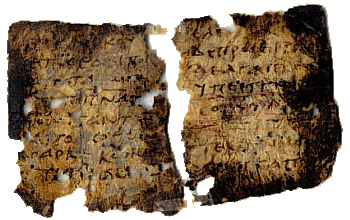
Next, let’s look at two specific instances of the Christian Bible’s usage of the term “Son of God” that was not in the original text or was in the original text but later taken out.
Matthew 24:36: But of that day and hour no one knows, not even the angels of heaven, but My Father only.5
Alexandrian type-texts read: “But of that day and hour no one knows, not even the angels of heaven, nor the Son, but the Father only.” This includes the Codex Sinaiticus which was written in the 4th century CE.
Byzantine text-type texts read: “But of that day and hour no one knows, not even the angels of heaven, but the Father only”. This includes the Codex Alexandrinus which was written in the 6th century CE.
Why is this important?
A well-known example comes in Matt. 24:36, where Jesus is predicting the end of the age and says that “concerning that day and hour, no one knows – not the angels in heaven, nor even the Son, but only the Father. Scribes found this passage difficult: the Son of God, Jesus himself, does not know when the end will come? How could that be? Isn’t he all-knowing? To resolve this problem, some scribes simply modified the text by taking out the words ‘nor even the Son. – Bart Ehrman (Misquoting Jesus)6
Mark 1:1: The beginning of the gospel of Jesus Christ, the Son of God.7
The 4th century CE text Codex Vaticanus does include the text “the Son of God.” However, the 4th century Codex Sinaiticus excludes this part of the text.
Since the combination of B D W all in support of [Son of God] is extremely strong, it was not thought advisable to omit the words altogether, yet because of the antiquity of the shorter reading and the possibility of scribal expansion, it was decided to enclose the words within square brackets. – Bruce Metzger (Textual Commentary on the Greek New Testament)8
As we can see there are issues with the Christian Bible’s use of the term “Son of God” as it pertains to Jesus. There are clearly two references back to the Tanakh which are completely unsubstantiated. These references do not refer to Jesus in any way. There are also two instances of passages that are clearly scribal interpolations. This means that these two passages from the Christian Bible must be thrown out.
One of the earliest writings of Christianity that has survived is the Didache which makes no mention of Jesus being the “son of God.” In fact, Jesus is viewed as a prophet and servant of God – a very similar idea expressed in the Qur’an.
Perhaps the most significant element of the Didache’s doctrine concerns its understanding of Jesus. This primitive Judeo-Christian writing contains none of the theological ideas of Paul about the redeeming Christ or of John’s divine Word or Logos. Jesus is never called the “Son of God.” Astonishingly, this expression is found only once in the Didache where it is the self-designation of the Antichrist, “the seducer of the world…” (Biblical Archaeology Review, November/December 2012)9
For in the last days false prophets and corrupters shall be multiplied, and the sheep shall be turned into wolves, and love shall be turned into hate; for when lawlessness increases, they shall hate and persecute and betray one another, and then shall appear the world-deceiver as Son of God, and shall do signs and wonders, and the earth shall be delivered into his hands, and he shall do iniquitous things which have never yet come to pass since the beginning. (Didache – Chapter 16)10
The only title assigned to Jesus in the Judeo-Christian Didache is the Greek term pais, which means either servant or child. However, as Jesus shares this designation in relation to God with King David … it is clear that is must be rendered as God’s “Servant.” If so, the Didache uses only the lowliest Christological qualification about Jesus. (Biblical Archaeology Review, November/December 2012)9
And concerning the broken bread:
We thank Thee, our Father, for the life and knowledge which You madest known to us through Jesus Thy Servant; to Thee be the glory for ever. Even as this broken bread was scattered over the hills, and was gathered together and became one, so let Thy Church be gathered together from the ends of the earth into Thy kingdom; for Thine is the glory and the power through Jesus Christ for ever.. (Didache – Chapter 9)10
The switch in the perception of Jesus from charismatic prophet to superhuman being coincided with a geographical and religious change, when the Christian preaching of the gospel moved from the Galilean-Judean Jewish culture to the pagan surroundings of the Greco-Roman world.(Biblical Archaeology Review, November/December 2012)9
The term “son of God” is used copiously throughout the Tanakh in reference to both man and angels. This term in no way is an indication of a personage of God becoming flesh and allegedly dying for our sins.
——————–
5Blue Letter Bible. “Gospel of Matthew 24 – (NKJV – New King James Version).” Blue Letter Bible. 1996-2013. [http://www.blueletterbible.org/Bible.cfm?b=Mat&c=24&v=1&t=NKJV#top]
6Bart Ehrman Misquoting Jesus: The Story Behind Who Changed the Bible and Why. New York: HarperOne, 2007.
7Blue Letter Bible. “Gospel of Mark 1 – (NKJV – New King James Version).” Blue Letter Bible. 1996-2013. [http://www.blueletterbible.org/Bible.cfm?b=Mar&c=1&v=1&t=NKJV#top]
8Bruce Metzger. Textual Commentary on the Greek New Testament. Peabody, MA: Hendrickson Publishers, 2005.
9Geza Vermes. “From Jewish to Gentile: How the Jesus Movement Became Christianity.” Biblical Archaeology Review, November/December 2012, vol. 38 no. 6 (p. 58).
10Peter Kirby. “The Didache.” Early Christian Writings. 2013. [http://www.earlychristianwritings.com/text/didache-roberts.html]
